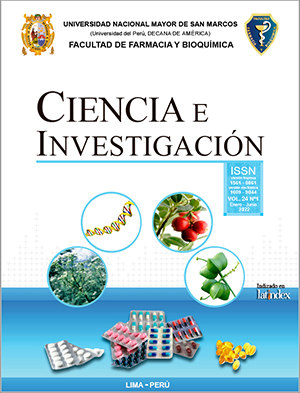Antibacterial activity of the essential oils of Minthostachys mollis Griseb. "Muña" and Piper carpunya Ruíz & Pav. "Pinku"
DOI:
https://doi.org/10.15381/ci.v24i2.22522Keywords:
Minthostachys mollis “muña”, Piper carpunya “pinku”, essential oil, antibacterial activityAbstract
Essential oil applications that act as antimicrobial agents are frequently studied for their ability to protect foods against pathogenic microorganisms. The antibacterial activity was determined by the minimum inhibitory concentration (MIC) of the essential oils of Minthostachys mollis Griseb. “muña” and Piper carpunya Ruíz & Pav. “pinku”. The “muña” collected from the district of San José de Lourdes-Cajamarca; and the “pinku”, from the Camporredondo-Amazonas district. Essential oils were obtained by steam distillation from the leaves; being the density of M. mollis 0.886 and P. carpunya 1.023; Using gas chromatography coupled to mass spectrometry (CG-MS), 24 compounds were identified in “muña”, the highest percentage being pulegone (40.94%), menthone (32.72%) and limonene (1.92%); and in “pinku”, 22 compounds, with the highest percentage being methyleugenol (40.49%), safrole (31.24%) and isohomogenol (7.5%). Each essential oil challenged microorganisms of interest in food hygiene: gram-negative bacteria such as Escherichia coli and Pseudomonas aeruginosa, and gram-positive bacteria such as Staphylococcus aureus and Enterococcus faecalis. The essential oils of M. mollis and P. carpunya exhibited a broad spectrum of antibacterial action for both gram-positive and gram-negative bacteria, with a MIC, in M. mollis, for S. aureus 8.86 µg/ml and E. coli 70.88 µg/ml and in P. carpunya, for S. aureus 5.12 µg/ml and E. coli 20.46 µg/ml. It is concluded that the essential oils used in this study, in low concentrations, have antibacterial activity against E. coli and S. aureus bacteria.
Downloads
Published
Issue
Section
License
Copyright (c) 2022 Kary Gonzales D., María Elena Salazar S., César M. Fuertes R.

This work is licensed under a Creative Commons Attribution 4.0 International License.
LOS AUTORES RETIENEN SUS DERECHOS:
- Los autores retienen sus derechos de marca y patente, y tambien sobre cualquier proceso o procedimiento descrito en el artículo.
- Los autores retienen el derecho de compartir, copiar, distribuir, ejecutar y comunicar públicamente el articulo publicado en la Revista Ciencia e Investigación (por ejemplo, colocarlo en un repositorio institucional o publicarlo en un libro), con un reconocimiento de su publicación inicial en la Revista Ciencia e Investigación.
- Los autores retienen el derecho a hacer una posterior publicación de su trabajo, de utilizar el artículo o cualquier parte de aquel (por ejemplo: una compilación de sus trabajos, notas para conferencias, tesis, o para un libro), siempre que indiquen la fuente de publicación (autores del trabajo, revista, volumen, numero y fecha).













